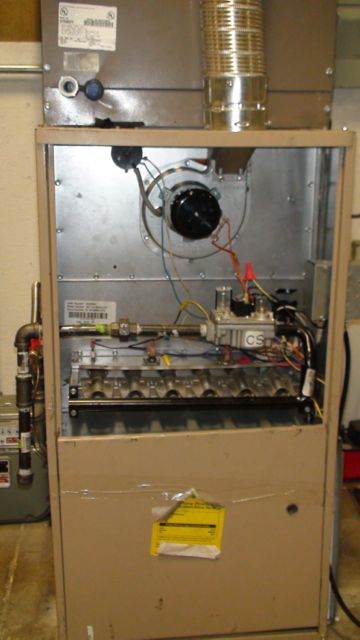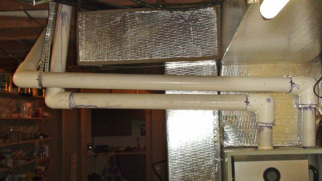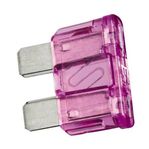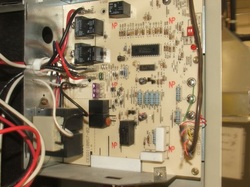- Home
- For the homeowner
- Safety
- Definitions
- Gas furnace
- Some error codes for gas furnaces
- Service sheet for the gas furnace
- gas furnace design
- The gas heat exchanger
- Dangerous conditions in gas furnaces
- Annual service of the gas furnace
- Repair procedures for gas furnaces
- Gas fireplace millivolt systems
- Oil furnace
- Setting gas input
- Quick tips for troubleshooting furnaces
- Troubleshoot
- Operation and troubleshoot furnace by manufacturer
- HVAC war stories blog
- Annual service of an oil furnace
- Oil furnace design
- Oil furnace troubleshoot
- Repair procedures for oil furnaces
- Gas code training
- Piping and connections
- FAG w pilot no fire
- Combustion analysis
- Electric furnace
- Air conditioner
- Refrigeration
- Heat Pump
- Boiler
- Ductwork design and troubleshoot
- Thermostats
- Diagnostic problems
- Tools
- Electric test meters
- Electrical diagram training
- Electrical symbols
- Single and 3 phase power systems
- Electric wiring solutions
- Transformer design and troubleshoot
- Electronic air cleaner
- Blowers and fans design & troubleshoot
- Humidity and humidifiers
- Furnace, Air Conditioner and part manuals
- Electric motors
- Run Capacitors
- Start capacitors
- Troubleshooting the capacitor
- Gas furnace short cycling
Troubleshoot a gas furnace 80% or 90% efficient No heat
The 80% furnace:
|
The 90% furnace:
|
When troubleshooting, understand you are working with potentially lethal voltages and a highly flammable gas. If you do not have the ability to do these operations safely, do not attempt them.
This page covers problems with electrical supply voltage. If you know voltage is available, click here
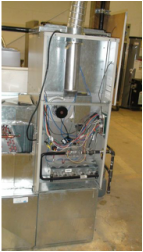
No heat, check home page first.
Find the window (lower right on pic). You should see a small light inside. Some furnaces have 2 lights. If it is on or blinking, there is power to the unit. If so, go here.
If it is off, there is no low voltage power to the unit. If the furnace was built within the last 25 years, it will probably be controlled by an IFC. Most IFCs have an automotive type fuse mounted on the IFC. If the fuse is blown, there has been a short in the low voltage. You can replace the fuse, however it may blow again. If so, the there is a short. The procedure here is first check all wiring. Many low voltage transformers have one side of the circuit hooked to chassis ground. If any wires are in contact with the chassis of the equipment, the fuse will blow. If you are proficient with a volt-ohm-ammeter, continue. (If you have a clamp on ammeter, you can bypass the fuse with a jumper wire. Place the clamp around the jumper wire. If, when the power is applied to the circuit, the amp draw exceeds about 1.6 amps, there is a short). Do not leave this circuit on with excessive amp draw. This will save on fuses.
If the wires are ok, follow the wires to the various components. Remove the wire from each component in turn with the power on and the thermostat calling for heat. If it blows with the wire removed from the component, the part is ok. Continue removing wires until the fuse does not blow. Then you have found the problem. In these furnaces, there are many components and you must do a thorough job. The key here is double check everything and be sure you are checking what you think you are. Below we have some videos covering how to look for shorts.
Find the window (lower right on pic). You should see a small light inside. Some furnaces have 2 lights. If it is on or blinking, there is power to the unit. If so, go here.
If it is off, there is no low voltage power to the unit. If the furnace was built within the last 25 years, it will probably be controlled by an IFC. Most IFCs have an automotive type fuse mounted on the IFC. If the fuse is blown, there has been a short in the low voltage. You can replace the fuse, however it may blow again. If so, the there is a short. The procedure here is first check all wiring. Many low voltage transformers have one side of the circuit hooked to chassis ground. If any wires are in contact with the chassis of the equipment, the fuse will blow. If you are proficient with a volt-ohm-ammeter, continue. (If you have a clamp on ammeter, you can bypass the fuse with a jumper wire. Place the clamp around the jumper wire. If, when the power is applied to the circuit, the amp draw exceeds about 1.6 amps, there is a short). Do not leave this circuit on with excessive amp draw. This will save on fuses.
If the wires are ok, follow the wires to the various components. Remove the wire from each component in turn with the power on and the thermostat calling for heat. If it blows with the wire removed from the component, the part is ok. Continue removing wires until the fuse does not blow. Then you have found the problem. In these furnaces, there are many components and you must do a thorough job. The key here is double check everything and be sure you are checking what you think you are. Below we have some videos covering how to look for shorts.
If upon replacing the fuse, it does not blow and there still is no light, (remember to tape the door switch closed), the transformer may be failed. You must then find the transformer. On the unit below, the transformer is mounted above the IFC. (Large component lower left). The wires from the transformer should be checked for voltage. There will be at least 2 wires on the high voltage side. There should a black and a white. Check voltage between them with a voltmeter. It should be 120v. If the voltmeter reads 0 the problem is not in the furnace. You must recheck breakers, fuses and power switches. Next, the output voltage should be checked. These wires could be any color. The wires should enter the IFC. It should be 24v. If the reading is zero, the transformer has failed. You can double check the transformer by isolating it electrically, and using an ohmmeter to check continuity of the windings. Be sure you are checking the black to the white on the primary. Then check the secondary. Both windings should show a resistance. If either winding shows an open, the transformer has failed. Some transformers have a fuse installed in the secondary winding, so if you have a short in the system, it will blow the internal fuse again. I recommend using a transformer without the fuse, then installing an inline fuse with the new one. Do not install a replacement transformer without a fuse. The transformer will smoke. (it sounds like bacon frying).
Once any transformer problems are repaired the IFC light should come on.
Once any transformer problems are repaired the IFC light should come on.
inline fuse
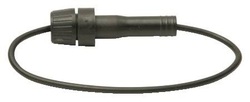
| servicing_gas_furnace.pdf | |
| File Size: | 36 kb |
| File Type: | |
